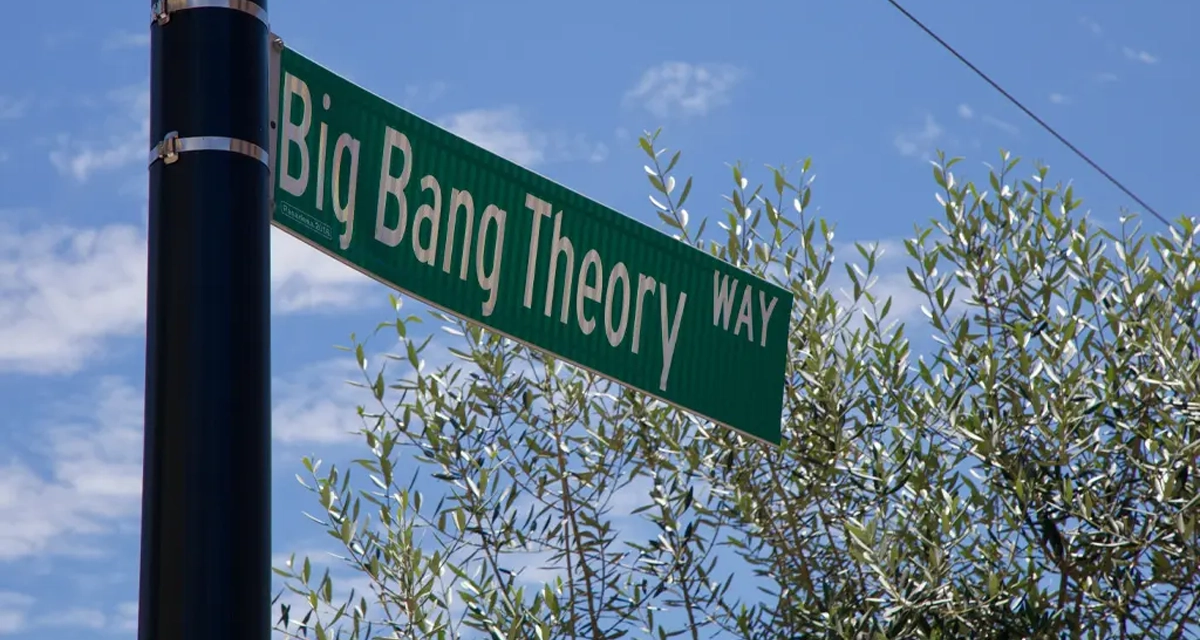What is the big bang theory?
How was our world created? How did the world we know now become a seemingly limitless place? What will happen in the world after this? These are examples of many questions that have occupied the minds of philosophers and scientists and have finally led to very strange, scary and interesting theories
Today, scientists, astronomers and cosmologists agree that the universe was created through a big bang. According to this theory, scientists believe that this big bang not only created the majority of matter, but also created the physical laws that govern our ever-growing and expanding universe.
This theory is known as the Big Bang theory. For almost a century, scientists and ordinary people refer to the Big Bang event as the most accepted form of the origin of the world, which should not be strange to us, because according to scientific evidence and research carried out by researchers, the theory The Big Bang is the most accepted theory about the origin of the universe.
But what exactly does the Big Bang theory mean? How did our current universe come into existence as a result of a huge explosion? What evidence is there for the Big Bang and what does this theory have to say about the long-term future of our universe?
The basics of this theory are relatively simple. The Big Bang theory states that all the present and past ingredients of the universe were created at the same time, approximately 13.8 billion years ago. At the time of the Big Bang, all the ingredients were compressed into a small ball with infinite density and intense heat (called the singularity) and suddenly the singularity began to expand, thus creating the universe.
Time line
Scientists proposed the theory of the big bang with experiments and reverse investigations of the current state of the universe. According to this theory, according to the big bang theory, the origin of our current universe must have started from a single point with infinite density and limited time that started to expand. According to this theory, scientists believe that after the initial expansion, the universe cooled enough to allow the formation of subatomic particles and later simple atoms. Giant clouds of these primordial elements later coalesced through gravity to form stars and galaxies. All the events related to the Big Bang explosion began about 13.8 billion years ago, so the time of the Big Bang event is determined based on theoretical experiments and experiments related to accelerating factors in the creation of the universe, the age of the universe. By studying particles and energetic states, as well as astronomical studies, scientists have been able to observe the depths of the universe and based on that, create a timeline of events that began with the big bang and led to the current state of the universe.
However, there is much speculation about the first moments of the Big Bang (which lasted from approximately 10-43 seconds to 10-11 seconds). Given that the laws of physics as we know them today could not exist at that time, it is difficult to understand how the world could have been created and managed in the beginning. In addition, due to the progress we have made in the field of physical science, we still have not been able to fully identify the experiments that can identify and create the types of energies involved in the creation and evolution of the world. However, many theories about what happened at the initial moment of time are often consistent.
singularity
This period, which is also known as Planck’s period or Planck’s age, is the first known period of the world. In Planck’s era, all matter was condensed on a single point with infinite density and intense heat. Scientists believe that during this period the quantum effects of gravity prevailed over physical interactions and no other physical force could have the power of gravity.
Planck’s time period extends from point 0 to 10-43 seconds. During Planck’s time period, due to the extreme heat and density of matter, the state of the universe was very unstable, so the universe began to expand and cool, and this led to the manifestation of the basic forces of physics.
From about 10-43 to 10-36 seconds, the universe began to pass through transitional temperatures. It is here that scientists believe that after these seconds, the forces governing the world began to separate from each other. The first force that was separated from other forces at this time was the force of gravity, which forms strong and weak nuclear forces and electromagnetism.
From 10-36 to 10-32 seconds after the Big Bang event, the temperature of the world was 1028 degrees Kelvin, this temperature was so low that electromagnetic forces (strong forces) and nuclear forces that interact It is enough to separate them from each other. This means the formation of two different forces.
Inflation epoch
With the formation of the first fundamental forces in the world, the period of inflation began. The period of inflation lasted from 10-32 seconds in Planck time to an unknown point. Most cosmological models show that the universe was homogeneously filled with high energy density at this time, and the extremely high temperature and pressure at that time caused the expansion and rapid cooling of the universe. This began at 10-37 seconds, at which time the phase transition that caused the forces to separate began a new period in which the universe grew exponentially. It was at this point in time that baryogenesis occurred. Baryogenesis refers to a hypothetical event in which temperatures are high enough that random motions of particles occur at relativistic velocities. As a result, particle-antiparticle pairs of different types were continuously created and then destroyed in collisions. Scientists believe that this action has led to the predominance of matter over anti-matter in the current world. After inflation stopped, the universe consisted of quark-gluon plasma as well as all other fundamental particles. From this point on, the universe began to cool and matter began to coalesce and take shape.
cooling epoch
As the temperature decreased and the density of the universe decreased, the energy of the particles decreased. As the phase transition of the fundamental forces continued, the fundamental particles transformed into the form they are now. The energy of the particles was reduced to a value that could be obtained by physics experiments, so from this period onwards we can speak more confidently about the events after this period and there is less speculation.
For example, about 10-11 seconds after the Big Bang, the energy of the particles dropped dramatically, according to scientists. In 10-6 seconds, by combining quarks and gluons, baryons such as protons and neutrons were formed and a small amount of quarks compared to antiquarks and a small amount of baryons compared to antibaryons were formed.
Because there was not enough temperature to create proton-antiproton pairs (or neutron-antineutron pairs), mass annihilation immediately occurred, leaving only one in 1010 protons and neutrons, and none of these antiparticles.
About 1 second after the big bang, a similar process happened for electrons and positrons. After these annihilations, the remaining protons, neutrons, and electrons no longer moved relativistic ally, and the energy density of the universe was dominated by photons—and to a lesser extent by neutrinos.
Minutes after the expansion, the nuclear Big Bang period began. Due to the decrease in temperature to 1 billion degrees Kelvin and the decrease in energy density to the equivalent of air, neutrons and protons were combined and formed the world’s first deuterium (stable isotope of hydrogen) and helium atoms. But even then, most of the protons in the universe still remained in the form of uncombined hydrogen nuclei.
After approximately 379,000 years, electrons combined with proton nuclei and created atoms. which were mostly hydrogen atoms. After that, the radiation energy was separated from the matter and to a large extent spread freely in the space without hindrance. Today, scientists have discovered that this radiation forms the cosmic microwave background (CMB), which is the oldest light in the universe today.
structure epoch:
After the next billion years, some denser regions of the universe’s nearly uniform matter began to attract each other gravitationally. Then they became denser and formed gas clouds, stars, galaxies and other astronomical structures that are discovered and observed today.
This is known as the Age of Structure because this is when the modern world began to be built. It consists of visible matter of various sizes, from stars and planets to galaxies, galaxy clusters, and superclusters scattered across the vast expanses that contain galaxies.
More information about the details of this process depends on the type and amount of matter in the universe, with cold dark matter, hot dark matter, hot dark matter, and baryonic matter being the four proposed types of matter. However, the Lambda-Cold Dark Matter Model (Lambda-CDM), in which dark matter particles move at a slower speed than the speed of light, is considered the standard model of Big Bang cosmology. because it has the most similarity and match with the existing data.
In this model, cold dark matter comprises about 23% of the matter or energy of the universe, while baryonic matter constitutes about 4.6% of the matter or energy of the universe. Lambda discusses the cosmic constant. This theory was first proposed by Albert Einstein, and in this theory, he presents his research and theory about the matter that the mass-energy balance in the world is constant. This has to do with dark energy, which has happened to accelerate the expansion of the universe and keep its large-scale structure largely uniform.
Long-term predictions:
The hypothesis that the universe was created at one point in time raises questions about whether the universe will ever end. If the universe started expanding as a tiny point of infinite density, does that mean it will continue to expand indefinitely? Or will it one day run out of expansion power and begin to retreat back to its original state, slowly receding inward until all the material is reduced to a small ball?
Scientists have always been looking for an answer to the question, which model of the universe is correct? Before the big bang theory was proposed and accepted, and before dark energy was observed in the 1990s, cosmologists mostly agreed on two theories about how the universe began.
In the first scenario, called the “Big Bang” scenario, the universe expands to its maximum size and then gradually begins to collapse in on itself after reaching its maximum size. This will happen only if the mass density of the universe is greater than the critical density. In other words, as long as the density of matter is in a certain amount or more than that certain limit, as a result, the universe will shrink and contract.
According to a theory, if the density in the universe is equal to or less than the critical density, the rate of expansion will slow down, but the expansion will never stop. In this theory, which scientists call the “big freeze,” the universe continues to live until all the interstellar gas in each galaxy is consumed and star formation stops. At the same time, all existing stars burn up and become white dwarfs, neutron stars, and black holes.
Gradually, collisions between these black holes lead to the accumulation of mass into larger and larger black holes. The average temperature in the universe will approach absolute zero and black holes will evaporate after emitting the last Hawking radiation. Eventually, the entropy of the universe will increase exponentially to the point where no specific form of energy can be extracted from it (these scenarios are called “heat death”).
Recent research, which shows the existence of dark energy and its effect on cosmic expansion, has led scientists to conclude that the possibility of “heat death” in this scenario can be considered as a possible end point.
Other explanations of dark energy, also known as phantom energy theories, suggest that eventually galaxy clusters, stars, planets, atoms, nuclei, and matter itself will gradually expand as they expand and break apart. became. This scenario is known as the “Great Gap” and eventually this expansion will be gradually neutralized.
History of the big bang theory:
The first observations about the possibility of the Big Bang occurred as a result of discoveries made about deep space observations in the early 20th century. In 1912, the American astronomer Vesto Slipher did some research on spiral galaxies (which appear to be nebulae) and measured their Doppler redshift. In almost all of his research, he observed that spiral galaxies are gradually moving away from our galaxy.
In 1922, the Russian cosmologist Alexander Friedmann continued and expanded his equations under the title of Friedman’s Studies. In these studies, he used Einstein’s equations for general relativity. Einstein supported his cosmological constant in his studies and equations, but Friedman showed in his studies that the universe is probably in a state of expansion.
In 1924, Edwin Hubble made measurements from the farthest measurable distance to the nearest spiral nebula and concluded that these systems are actually other galaxies.
At the same time, Hubble increased some distance detectors using the 100-inch Hooker telescopes at Mount Wilson Observatory.
In 1929, Hubble discovered the relationship between distance and the velocity of stagnation – this law is now also known as Hubble’s law.
Then in 1927, Georges Lemaître, a Belgian physicist and Roman Catholic priest, independently obtained the same results as Friedman’s equations and proposed that the inferred stagnation of galaxies was due to the expansion of the universe. In 1931, he expanded on the theory and proposed that what we now conclude about expansion is that the universe was smaller in the past. According to his arguments, all the mass of the world in a period of time in the past was concentrated in a single point, which basically the structure of space and time starts from that point.
These discoveries sparked debate among physicists and scientists in the 1920s and 1930s, but most of them supported the idea that the universe was in a steady state. In this proposed model, with the expansion of the universe, new matter is created continuously, and as a result, the uniformity and density of matter is maintained over time. At that time, scientists considered the Big Bang theory to be a theological theory rather than a scientific theory, and they accused Friedman of being anti-religious because of his religious beliefs from the past.
At this time, other theories such as the Milne model and the oscillating world model were also supported. Both of these theories were presented from Einstein’s theory of general relativity, which was also approved by Einstein himself. They believed that it follows an infinite and self-perpetuating cycle.
After the Second World War, the disagreement between the supporters of the Big Bang theory and the supporters of the steady state model grew. In 1949, Hoyle invented and used the word Big Bang for the first time in a radio program.
Eventually, scientists began to support the Big Bang theory over the steady state using observational evidence.
In 1965, with the discovery and confirmation of the cosmic microwave background radiation, scientists came to the conclusion that the Big Bang could be the best and most probable theory about the origin and evolution of the universe. From the late 60s to the 1990s, astronomers and cosmologists, based on papers by Stephen Hawking and other physicists, demonstrated that singularities are an inevitable precondition of general relativity and the Big Bang theory. In 1981, physicist Alan Guth theorized a period of rapid cosmic expansion (known as the “inflation”) that solved other theoretical problems.
In the 1990s, dark energy was also used as a solution to outstanding problems in cosmology. The theory of the missing mass of the universe and an explanation of why the universe is always accelerating was presented.
Due to the construction of advanced telescopes and satellites, as well as professional simulations made by computers, we saw a significant progress in the field of cosmology, which made cosmologists know more about the world and a better understanding of the real age of the world. get the
The use and construction of space telescopes – such as the Cosmic Background Probe (COBE), the Hubble Space Telescope, the Wilkinson Microwave Anisotropy Probe (WMAP) and the Planck Observatory – have also been of great value in increasing the awareness of scientists and their discoveries and observations.
Today, cosmologists have been able to carry out more detailed research using the existing facilities of cosmology and can have more information in the field of the Big Bang theory. According to these observations, larger stellar objects light-years away are slowly moving away from us.
However, we do not know exactly how the world will end, but we know that according to the cosmological scales, this event will not take a long time.





